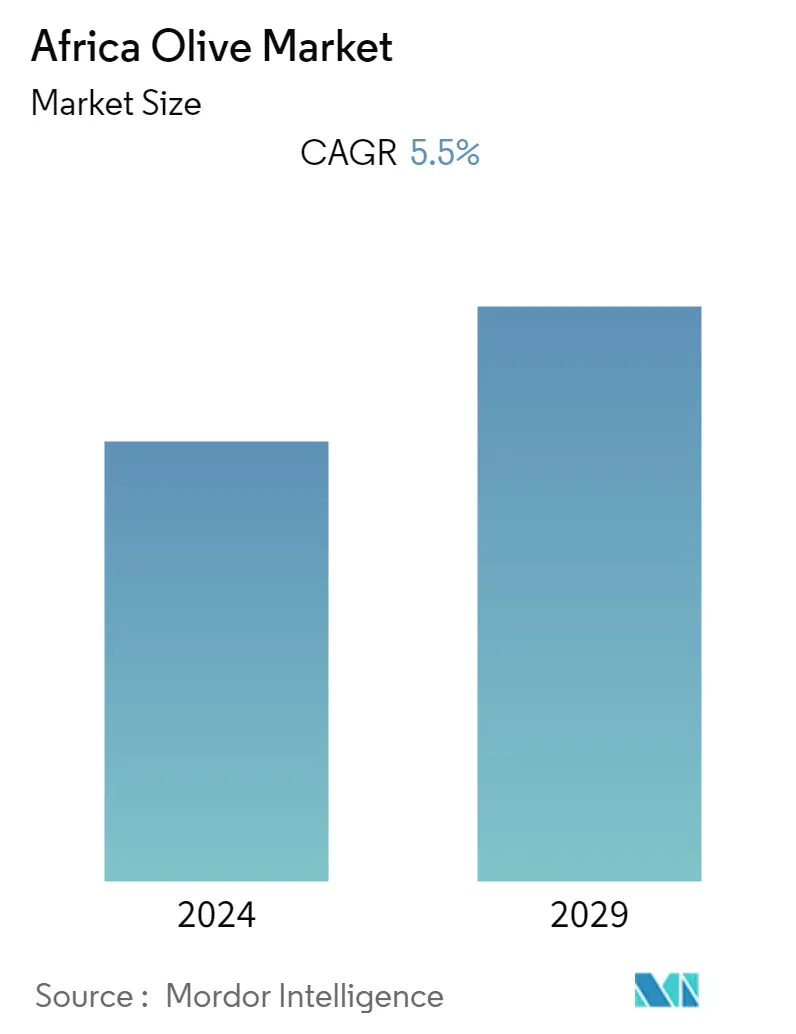Market Size of Africa Olive Industry

| Study Period | 2019 - 2029 |
| Base Year For Estimation | 2023 |
| Forecast Data Period | 2024 - 2029 |
| Historical Data Period | 2019 - 2022 |
| CAGR | 5.50 % |
Major Players*Disclaimer: Major Players sorted in no particular order |
Africa Olives Market Analysis
The Africa olive market is expected to register a CAGR of 5.5% during the forecast period.
- Olive oil, cereals, fruit and vegetables, and dates have long been the foundation of agriculture in Africa, and efforts are being made to modernize the sector through the development of agri-business. Yet, agriculture remains largely dominated by small family farms. In addition, initiatives to reorganize production to boost efficiency and equity are being implemented, notably in the form of cooperatives. Morocco is the largest producer, with 1.5 million in 2021, followed by Egypt, Algeria, and Tunisia, some of the other top olive production countries in Africa.
- In 2023, Spanish olive oil consumers are likely to turn to other markets like Morocco for the product, as prices remain high due to rising production costs and drought, standing at more than five euros per liter for extra virgin olive oil and around five euros for virgin and lampante olive oil. Despite this price increase, Spanish consumers continue to buy olive oil because they have no other alternative. Sunflower oil has also become more expensive after the Russian invasion of Ukraine.
- The government has prioritized improving irrigation, and increasing market productivity since olive has the potential for much more growth, especially in terms of higher value-added organic olive oil. Some factors driving the olives market are the rise in the demand for olive oil, dietary benefits, and pharmaceutical uses, which will boost the market's growth during the forecast period.
Africa Olives Industry Segmentation
Olive is an evergreen tree, Olea europaea, of the Mediterranean and other warm regions, cultivated chiefly for its fruit.
The Africa olive market is segmented based on Geography ( Morocco, Algeria, Tunisia, Egypt, and Libya). The report includes production analysis (volume), consumption analysis (value and volume), export analysis (value and volume), import analysis (value and volume), and price trend analysis.
The report offers the market size and forecast in both value (USD million) and volume (metric ton).
| Geography | |||||||
| |||||||
| |||||||
| |||||||
| |||||||
|
Africa Olive Market Size Summary
The African olives market is poised for significant growth, driven by a compound annual growth rate during the forecast period. The region's agriculture, traditionally centered around staples like olive oil, cereals, and dates, is undergoing modernization efforts through agri-business developments and cooperative initiatives. Morocco stands out as the largest producer of olives in Africa, with other notable contributors including Egypt, Algeria, and Tunisia. The demand for olive oil is on the rise, fueled by its dietary and pharmaceutical benefits, which is expected to further propel market expansion. Despite challenges such as high production costs and drought affecting Spanish olive oil prices, the demand for olive oil remains robust, with consumers increasingly opting for healthier cooking oil alternatives.
Morocco's strategic initiatives and favorable agro-climatic conditions have positioned it as a leading producer and exporter of extra virgin olive oil globally. The country's unique micro-climate and geological conditions contribute to the high quality of its olive oil, renowned for its health benefits. Government efforts, supported by international organizations like the FAO and EBRD, continue to bolster the olive oil sector, enhancing production and export capabilities. The rising international demand for Moroccan olives and the country's expanding olive oil production capacity underscore the promising market opportunities in the African olives industry. As Morocco continues to increase its olive production, it is set to become a significant player in the global olive oil market, alongside traditional producers in the European Union.
Africa Olive Market Size - Table of Contents
-
1. MARKET DYNAMICS
-
1.1 Market Overview
-
1.2 Market Drivers
-
1.3 Market Restraints
-
1.4 Value Chain Analysis
-
-
2. MARKET SEGMENTATION
-
2.1 Geography
-
2.1.1 Morocco
-
2.1.1.1 Production Analysis
-
2.1.1.2 Consumption Analysis and Market Value
-
2.1.1.3 Import Market Analysis (Volume and Value)
-
2.1.1.4 Export Market Analysis (Volume and Value)
-
2.1.1.5 Price Trend Analysis
-
-
2.1.2 Algeria
-
2.1.2.1 Production Analysis
-
2.1.2.2 Consumption Analysis and Market Value
-
2.1.2.3 Import Market Analysis (Volume and Value)
-
2.1.2.4 Export Market Analysis (Volume and Value)
-
2.1.2.5 Price Trend Analysis
-
-
2.1.3 Tunisia
-
2.1.3.1 Production Analysis
-
2.1.3.2 Consumption Analysis
-
2.1.3.3 Import Market Analysis (Volume and Value)
-
2.1.3.4 Export Market Analysis (Volume and Value)
-
2.1.3.5 Price Trend Analysis
-
-
2.1.4 Egypt
-
2.1.4.1 Production Analysis
-
2.1.4.2 Consumption Analysis
-
2.1.4.3 Import Market Analysis (Volume and Value)
-
2.1.4.4 Export Market Analysis (Volume and Value)
-
2.1.4.5 Price Trend Analysis
-
-
2.1.5 Libya
-
2.1.5.1 Production Analysis
-
2.1.5.2 Production Analysis
-
2.1.5.3 Import Market Analysis (Volume and Value)
-
2.1.5.4 Export Market Analysis (Volume and Value)
-
2.1.5.5 Price Trend Analysis
-
-
-
Africa Olive Market Size FAQs
What is the current Africa Olive Market size?
The Africa Olive Market is projected to register a CAGR of 5.5% during the forecast period (2024-2029)
What years does this Africa Olive Market cover?
The report covers the Africa Olive Market historical market size for years: 2019, 2020, 2021, 2022 and 2023. The report also forecasts the Africa Olive Market size for years: 2024, 2025, 2026, 2027, 2028 and 2029.

